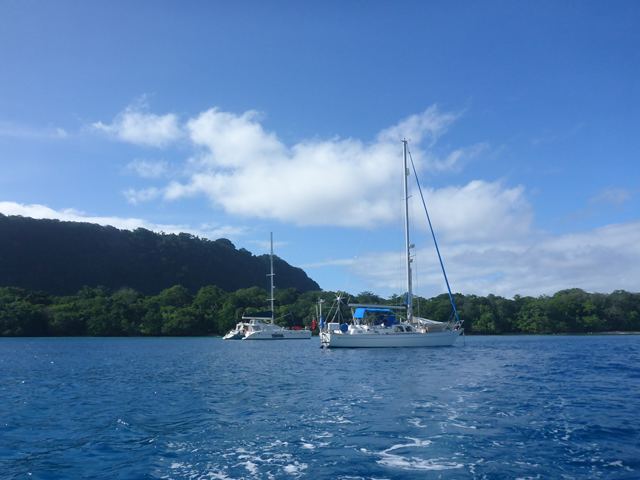I should have twigged when Andrew signed off the VHF with the words “so you can come and pick me up” that he was coming by road and would need a lift to the boat. Soon a uniformed figure was leaning against a palm tree on the resort frontage and Rob and I dashed through the process of unpacking and inflating the dinghy and lowering the motor onto the stern in a quarter the normal leisurely pace. The repaired motor behaved itself too and Rob sped off at a new found speed to the beach.
I didn’t know until he stepped aboard and introduced himself that he was the chap who replied to my email from NZ enclosing the Inward Docs and wishing us a safe voyage.
“Would you like some water?” I asked. “Do you have any coffee, I haven’t had any breakfast?” So while he tucked into his daddy bear sized bowl of porridge, Arnott’s Kingston choccy bics and a mug of coffee, Rob and I listed the school stationery we had brought with us and called up Steph of the Sharm Foundation to see what she wanted doing with the three boxes of school uniforms that were literally blocking up the forward heads. Steph wanted to check them on to customs in Port Villa so they will be crewing for us for another month.
When we heard their destination is Naone on Maewo Island just to the east of us, remember the booby’s circle of islands, Andrew’s ears pricked up, “That’s where my family are from!”
Passports checked we chatted about this and that and he enquired about bio goods that we might be carrying, and at that point I thought a little distraction was necessary, “Em just some cheese for supper, did you go to the school there? What a coincidence that would be.”
“No, but possibly my grandfather did.” The cheese, mayo and garlic were safe.
He told us where to find the Immigration Office painted blue and white and lacking a sign, but it’s through wire gates first and then his Customs Office in the compound just beyond, both at the far end of the main street, Boulevard Higginson and on the right hand side, channel side of the road. He omitted two essential facts which I will explain later.
Getting ready on board as the sun was reaching its zenith the intensity of the heat could be felt even from where I was sitting, at the time on the loo.
“We could wait until this afternoon darling when it’s not quite so hot and there’s more shade?” Rob wanted to walk into town you see.
“No I want to go now,” came the unusually petulant reply from my man boy.
Our first sortie ashore lacked the grand uniformed nature that would have surrounded it in Cook’s day, with flags, Tricorn hats and golden epaulettes catching the sun’s rays as the Endeavour and Resolution relaxed in the bay; there were hats though, a Tilly Hat and a wide brimmed straw hat.
Tilly and Straw whizzed ashore, “Wow she’s nearly on a plane Rob,” he replied,
“Yes and that’s a first in a while.”

We made ourselves known in Reception at the resort and the kind lady gave us some brochures and resort details, all in French, no problem good for the translation skills and it was out into the courtyard with its pretty border of flowering tropical plants, the fuchsia coloured hibiscus in particular was a picture.
A rough track led to the road along the side of which was a narrow foot worn path and there was plenty of traffic, mostly pickups, lorries and taxis.
“Flag down a taxi,” the reception lady had said, “It’s only 200 vatu.” (140 vatu = £1, in 1998 it was 175. Tilly insisted we would walk, “We need the exercise and we’ll get to know the area.” Straw agreed with that bit but only mad dogs and Englishmen & a few locals with skins that protect them go out in the noonday sun. Straw remembered being in this situation at least twice before in Bahia and Suva, “I will do this once and only once, OK.” She can be forthright at times!
Thirty minutes later our hats crossed the bridge over the surprisingly wide and pleasantly clean Sarakata River and started to absorb the atmosphere of the busy street. 75% of businesses in Luganville are Chinese owned leaving the 24 hour fresh fruit and veg market, the Independence Park next to it, the administrative offices, local craft shops and tour operators in local and national ownership. Vanuatu gained independence from a confused mix of British and French Governance on 31st July 1980 and is now a republic.
Tilly drew some money out discovering that various banks charge different transaction fees and the best we found to be BSP (Bank of the South Pacific) in a green building on the left side of the road. You may have gathered I am giving some detail for cruiser friends who might follow us.
Two hats reached the end of the buildings and asked American Grey cap if he knew where the Immigration Office was. Grey cap advised its location and the fact they would not be back from lunch until 1.30. So Tilly and Straw get together and come up with a plan. 1) Umbrella 2) Lunch.
The road is in essence a dual carriageway and the only way to cross is to get to the middle and play on the kind hearts of the motorists coming to one’s right and they usually flash their lights to confirm you can cross but beware of the vehicle coming along the curb-side who might not have seen you.
The Natangora Café boasts it is the oldest in town having been around since 1990 and Tilly, and now red and white brolly, make for its shady interior for a light but quite pricy lunch of consommé followed by fish nuggets, rice and salad, washed down with local Tusker beer. (£32)
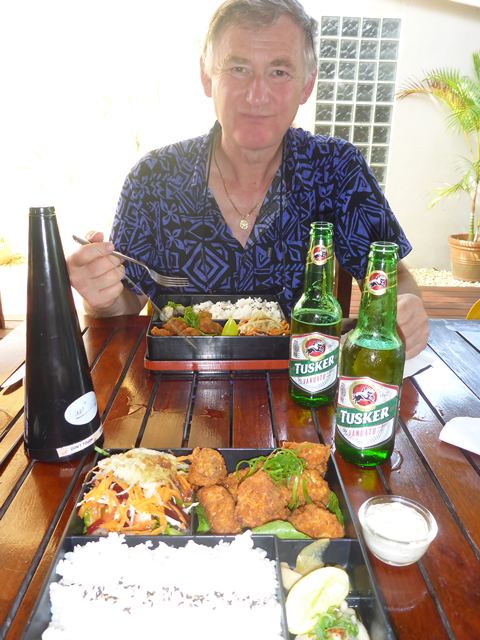
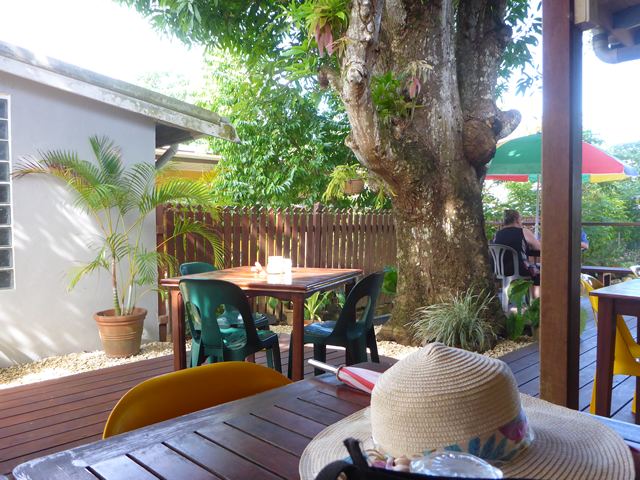
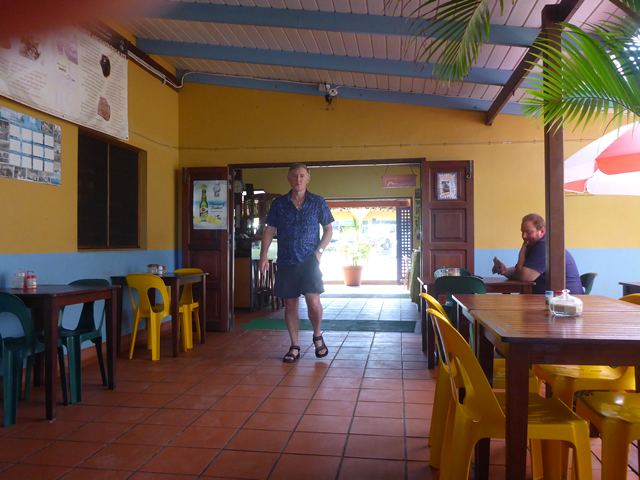
The doorway seemed like a filter, locals looked in only and the clientele was mostly made up of business people, and children of professionals, solo travellers and cruising types.
Back along the eastern half of the street our two hats climbed the steps to the office mindful that the banister and balustrade were as rusted as the nearby pilot boat backed up onto a rock. The nice young Immigration Officer was happy to see them but ‘oh’ we didn’t have the green receipt from the green cashier in the green Government Treasury Department nearly opposite the Natangora Restaurant.
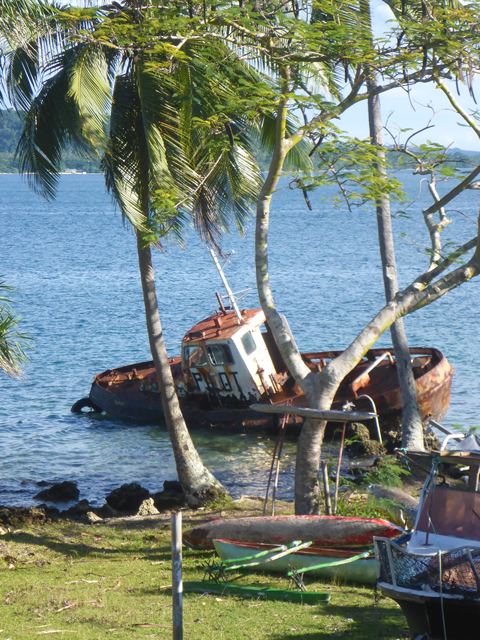
Tilly and Brolly stumble back down the steps and along the street on the shady side (!) find the building almost next to the main supermarket, LCM, climbed the three flights of stairs and a few moments later climbed back down, 4800 vatu lighter and with Tilly clutching the green receipt in his hand.
Tilly and Brolly are by now well beyond the benefits of the walk, the brolly (which keeps collapsing anyway) and their lunch, they are also beyond caring, so progress back comes with the optimism that they are finally getting somewhere and on entering the IO they are almost buoyant with smiles and bonhomie.
They take a pride in their job here and the young man checks carefully on a bit of scrap paper to make sure the ink on the stamp will not smudge on the passport pages. Straw even jokes as she sees the stamp lifted off the page,
“But there’s no volcano on it.” They laugh, fortunately. All done and lots of smiles and ‘Pop’ a blue balloon disintegrates as it is being attached with many others to a lovingly restored blue and white fishing boat down below, which is to be used as a prize at a fisherman themed event in the park.
Just a short distance now to Customs along a mercifully tree-lined road where parked up taxi drivers loll in the shade exploring messages on their phones. It was nice to see Andrew’s friendly face again and he took our green inward cards and said he would have our Inter Island Cruising Permit ready for us within the 24 hours before we plan to leave.
Back along the shady shore side track they had discovered after the lunch, and after they changed the umbrella for one that stays up, they wandered past a shoreline of rusting steel harbour wall and concrete blocks left over from the American WW2 activities, until they arrived at the market where papaya and bananas filled their bag and a taxi whisked them back to the resort.
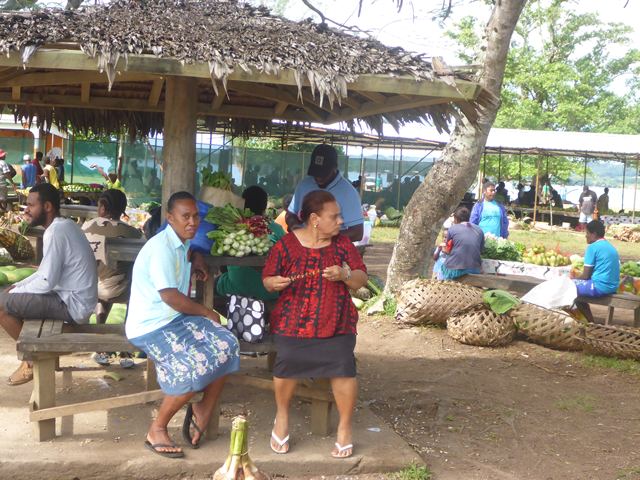
The cold showers were bliss. Then Rob noticed the date stamp on the passport said 30 days where Andrew had told us we were entitled to 90 as British Citizens. So the next day Tilly and Straw flagged down a passing taxi and witnessed a near disaster.
A white taxi pulled in to a drive back down the road behind us as a pickup truck full with uniformed school boys came toward the drive along the main road. A group of school girls was also walking towards us and the town. A pedestrian was approaching the same drive and the taxi driver was concentrating on getting out before he needed to cross the drive so he didn’t look left. It all happened in a second, the girls (who were watching the boys) and the pedestrian yelled at him to stop, the truck braked and lurched across the road by which time, fortunately the taxi had stopped. All was well but had the truck rolled it would have been carnage.
Back up the concrete steps to be faced with the sign ‘Gone to clear passengers in at airport, back at 4.00pm. So we gave up, decided to check it out on Google and visited two tour offices to get some details instead. This time the market yielded more papaya (we do like it) tomatoes and bok choy all day fresh, organic and inexpensive. Most things like the tomatoes, medium papaya and bundles of bok choy were 100 vatu.
The taxi driver tried to charge 50% more than the accepted fare in to town of 200 vatu but he didn’t expect the reaction he got from Tilly and Straw and gave the 100 vatu change back. Cheeky man.
A detour into the lovely cool bar for some Tusker brand beer (there are lots of feral boar, tuskers, around and the ones with double curly tucks are highly valued in their grade ceremonies, more on that later) and free Wi-Fi, which extends to Zoonie thanks to a boost from our Wi-Fi bat.
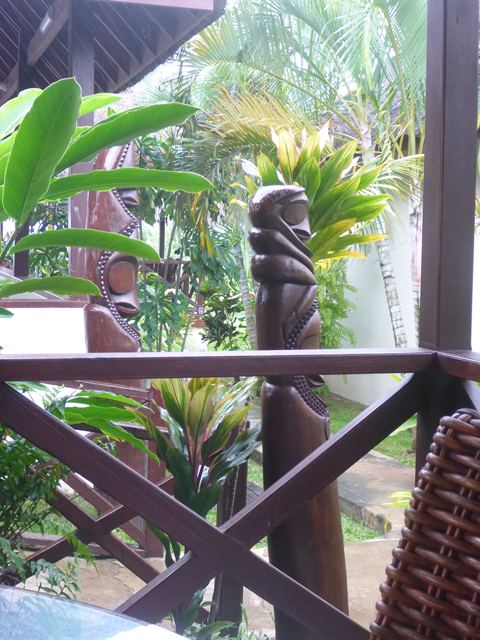

Yesterday the weather was wet and windy so a restful but productive day was spent aboard. There is a weather system approaching with lots of rain in it. We toyed with the idea of moving across to the other side where we heard there were moorings off the Aore Resort and we would be under the protection of the island but in a chat on the VHF with the lady she suggested there was only one and it is occupied. Rob asked if the mooring would take 15 tons. She suggested we pick up a mooring and go ashore to chat about tonnage etc but of course we need a secure mooring to attach to before we can get ashore. A Catch 22 methinks.
Yesterday I called them up and we got no reply. We are of a mind to trust our anchor rather than a mooring we do not know and if its heavy rain we’re worried about, well every yacht will get a good soaking no matter where it is eh!
A Dragging Yacht and the People from Mere Lava Island
Our weather forecast told us to expect a wet and windy day the next day so as soon as our morning chores were done we went ashore, caught a bus to town and shopped at LCM for eggs and rice and booked our culture trip to Leweton Village, then wandered to the market where some fresh white kumara, cucumber and bananas filled our cotton bags.
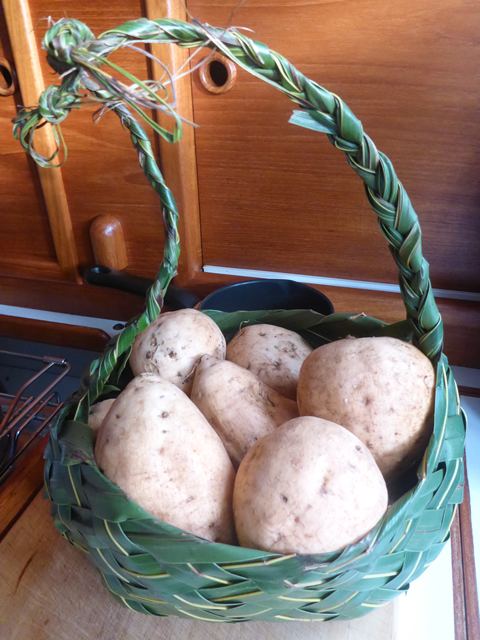
Back at the resort and over a welcome cold beer we chatted on Facetime with Rob’s sister Sue who is going through the difficult process of living without her husband Bernard who died recently.

In the evening we started watching Deadwood about the folk in the lawless gold rush town in the Black Hills of South Dakota in the 1870’s with famous characters like Wild Bill Hickok and Calamity Jane taking lead roles. A beautifully scripted and well-acted window on the psyche of the people of those dangerous times. One hundred years later in 1976 hubby Stuart and I passed through the area and visited the site of the Battle of The Little Big Horn where General George Armstrong Custer of the US army fought and died at his last stand.
Early the next morning, around 8.30am a mighty and sudden gust of 29 knots hit our little fleet of nine anchored yachts bringing with it a mantle of rain and wind which lasted for the best part of the day. Rob was making his way to the companionway for a look out when he saw the 47’ Beneteau, that had anchored uncomfortably close the evening before shoot backwards past us just a few metres away dragging his anchor. Alarmed and relieved at the same time I grabbed the foghorn and gave him a good blast with the hope of getting him on deck at least. Whether he heard it or not I do not know but eventually he appeared, his vessel having found a new location this time very close to two others boats.
He was the only one to leave his tender in the water the night before and we wondered if he even knew the blow was due, even knew when he started dragging, even knew he was aboard a yacht anchored off Espiritu Santo! He didn’t emerge onto the foredeck to check the anchor and chain and we were not sorry when he left the next morning. If he had hit us the potential damage does not bear thinking about.
The wind eased by the afternoon and we benefited from the 100% battery charge Ruby the Rutland wind charger had given us and as the rain continued for a few more hours when it did clear Zoonie shone in the next sunlight from her thorough wash off.
By contrast that night was blissfully calm and the mast head anchor light of another yacht sometimes found its way through our cabin porthole and through my eyelid into my dreams. The gentlest cool breeze would come over us and we awoke to the smell of woodsmoke and sodden earth and the usual barking of dogs and cocks crowing.
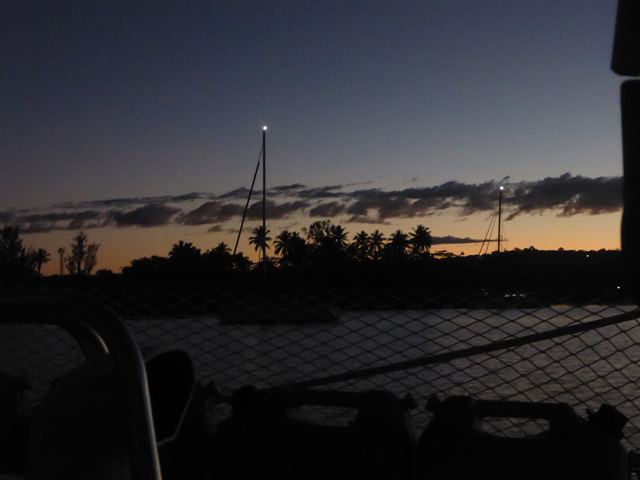
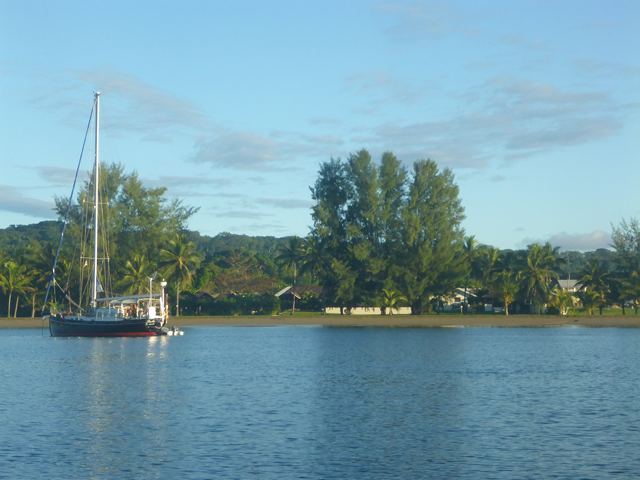
Our taxi driver that day was a friendly and curious chap, just as well because we had four 20 litre diesel cans to fill and things got a little complicated. We exchanged questions freely and I discovered that it is the local council of residents who decide on the taxi fares and at present 200 vatu in to town was thought to be reasonable and 300 was too much. Also they learn to drive from their friends and family and buy their permits to drive and their licences to be taxis from the authorities! He complained that he pays his taxes but doesn’t know where the money goes, “Certainly not on the roads!” His words.
We filled the cans with fuel at 154 vatu a litre (£1.1 about the same as UK) but then found our question on whether the garage took cards must have been misunderstood. So the driver then took us in to the nearest ATM (BSP Bank of South Pacific – cheapest fees) to get some more cash with the cans in the boot, they’re very trusting here, and then back to said garage to pay and on to the resort, all with friendly good humour.
While decanting the fuel in to Zoonie’s tanks Rob spotted a Dugong, a sea cow similar to a Manatee but with a whale like fluke unlike the manatees spade tail. He wasn’t the only one we saw either as you will see later. They are very discreet about surfacing every five minutes or so to breathe. First he appeared to poke his nose above water to exhale, then he swims along with his back just breaking the surface, then takes a couple of breaths, arches his back and dives, his fluke just curving over above water level in a liquid smooth dive.
We had been keenly anticipating our visit to the Leweton Village the next day. Lily and her driver were due to collect us in their van at 1.30pm so knowing our time here was coming to an end we had a nice walk along the beach where the locals were fishing and swimming and the now well rusted US forces landing stages were a constant reminder of their presence. Swallows by the hundred ducked and dived all day long, maybe they are helping keep the mosquito population at bay because since arriving we have not seen a single one, despite our taking daily anti-malaria tablets!
Leweton Cultural village, or compound, as Celia called it, is not big enough to grow any vegetables to eat but the community members might well have their own vegetable gardens around their huts which are outside the compound. Either way they like to go into town to the market and to buy staples like rice. I wondered if that is another reason they came to Espiritu Santo, to get away from their isolated existence.
The area we visited is made up of an arena with shaded seating, what used to be mutually exclusive mens’ and womens’ communal huts, on our visit a young man came into the ladies hut to give a fire lighting demonstration, and a swimming pool for the water music demonstration all set in neat gardens.
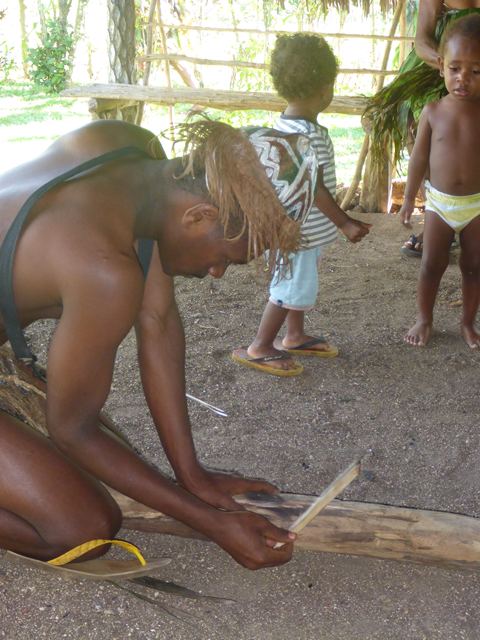
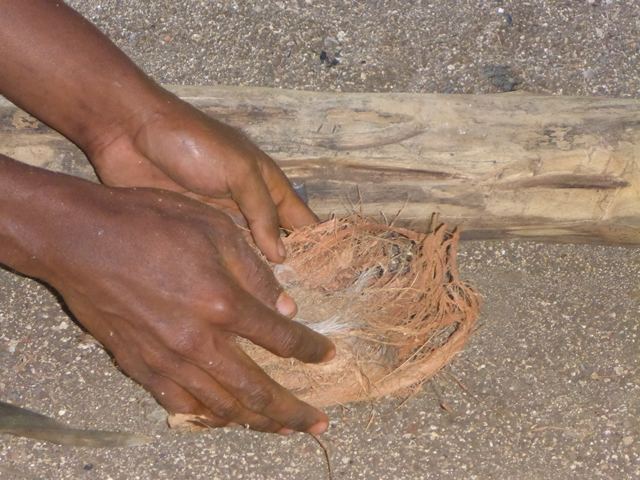
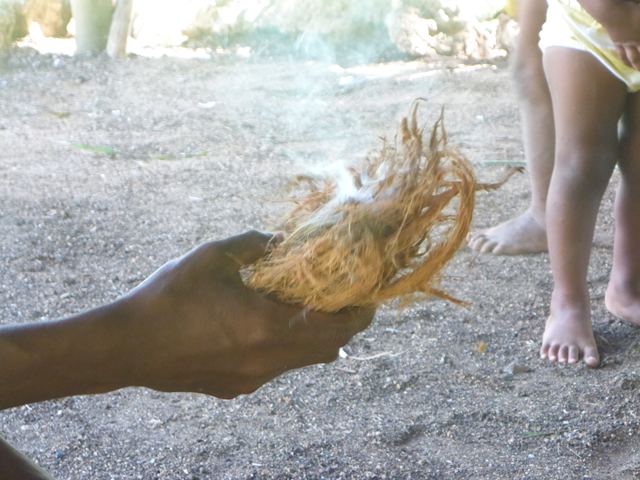
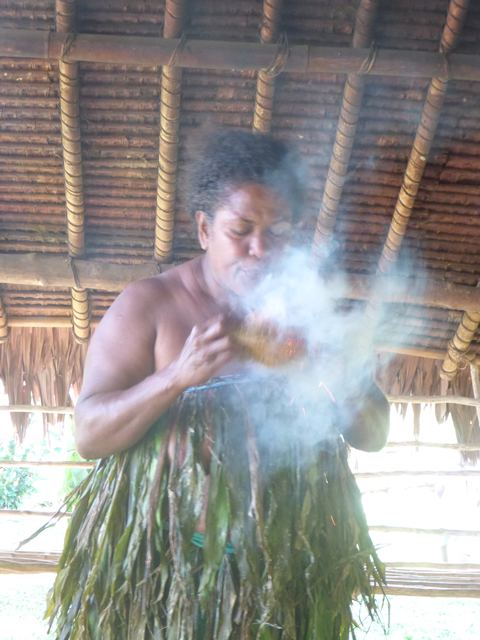
Celia (standing in front of her fire) came from Mere Lava Island (Big child), in the Banks Group to the north, 28 years ago “The hospitals and schools meant we could give our children a better life, and there is a better choice of food.” She said as she handed us some freshly grated coconut and tasty roasted plantain. But in exchange they gave up their longevity. Two sisters sitting opposite us in the womens’ hut were sixty one and sixty five (the eldest) and their father was still thriving at 102 years, in the past it was common for the people to live up to 105 or even 110 years of age. “Because he has never eaten processed food or drunk alcohol. But today our people are dying at a younger age.”

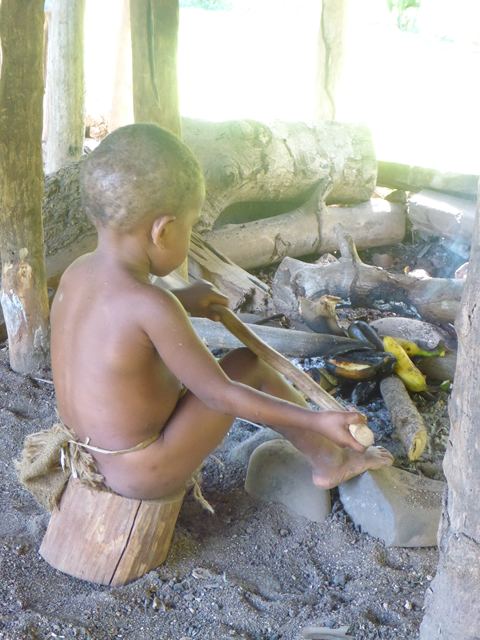
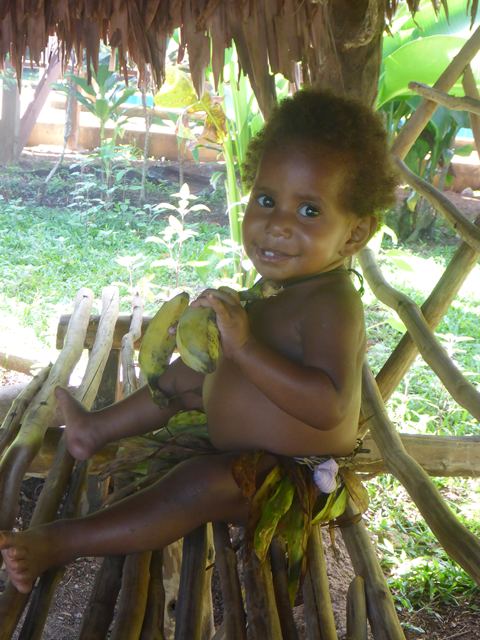
These days, when their education in English as well as their own language and other subjects is complete, many of the young people in her village work in and around the town; often the men come home for supper and then go to one of the many kava bars for a drink in the evening; that sounded a little like we used to do, going to The Grainstore Pub every Friday to celebrate the end of the working week. But in the past her people used to only drink kava during ceremonies as part of their tradition and not as a leisure beverage.
In the men’s hut we watched the young chief making kava from the fresh green root, grated with a limestone from the shore. He squeezed the liquid from the grated root into a cup and then strained it three times through coconut husk matting before diluting it with fresh water; I wondered if he always did the last part as undiluted it would have a stunning effect on the drinker. It had a fresher flavour compared to Fijian kava which is dried before the mixing begins. A small number of the young men were part of the experience and Lily was grateful we had given them notice of our visit so she could make sure there were enough present and they weren’t elsewhere, possibly working.
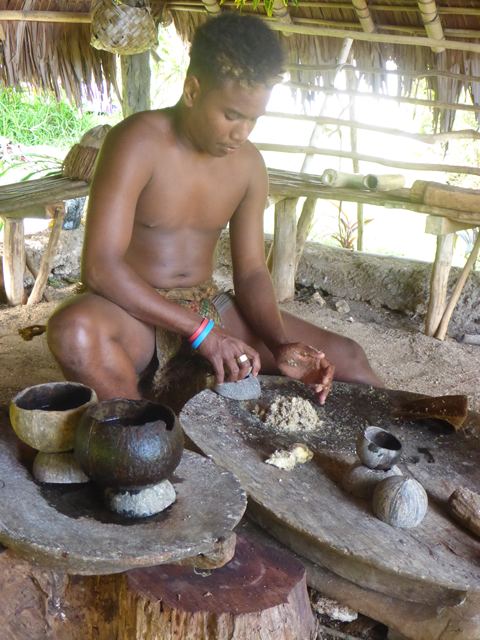
She led us back to the arena with her youngest of five children and the other pre-school youngsters who loved to take part in the lively dancing by first the women, with us joining in and then the young men armed with spears; carrying on their traditions was in safe hands here!
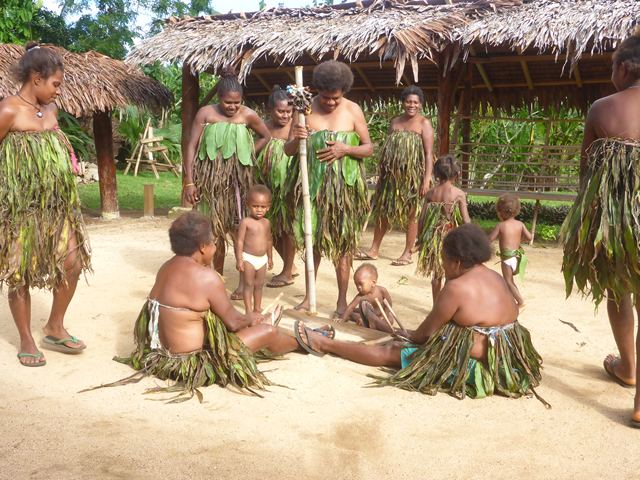

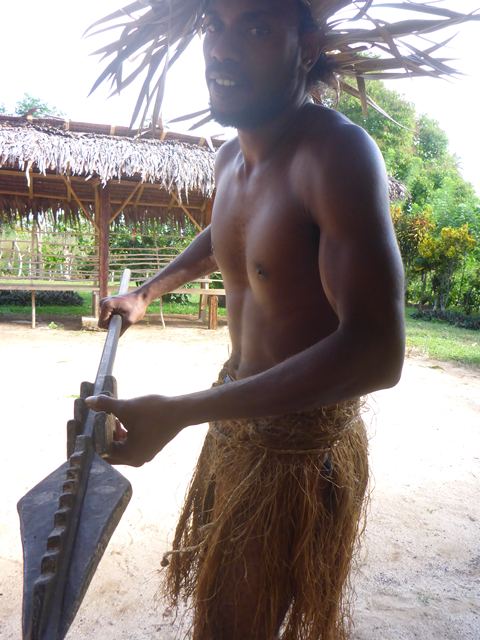
Last in the bag of cultural delights was the Traditional Vanuatu Water Music. Cupped hands gave a resonant beat and splayed fingers through the water a liquid moan like rubbing a wet finger on a shiny surface. Then of course there was the slapping and splashing all used to tell the stories of cascading waterfalls, rain on the roof, thunder, water rippling over pebbles and boiling water. Using water as a percussion instrument, like a military drum was as novel to us as it was refreshing to the ladies. Water is all important to these people, “Without water Peace and Unity cannot exist. Water is life.” I’m not sure who Sandy Sur is or was but I concur with her sentiments.
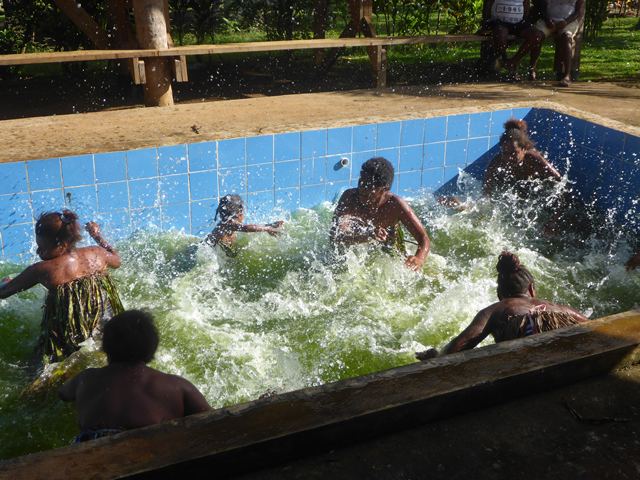
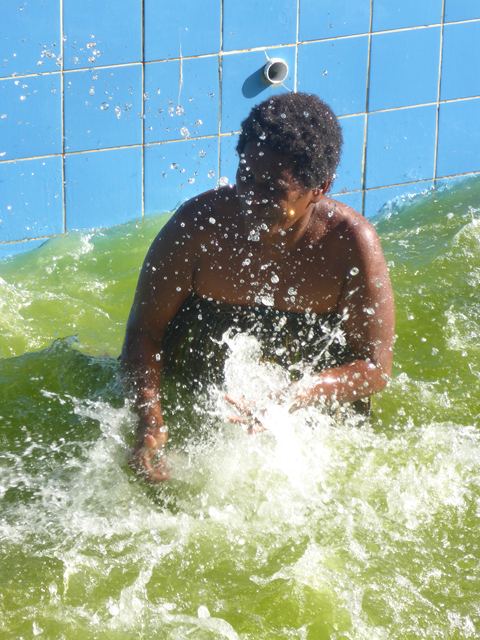
Our visit concluded with the ladies singing a farewell song and then everyone, even Lily’s baby, wanted to shake our hands. As we climbed into the van to return to the resort we waved farewell to the ‘performers’ making their way the short distance back to their huts with older children walking up the track from school, where two worlds meet amicably.

During the night we were awoken to the sound of Zoonie’s standing rigging rattling despite their being no wind, an earth tremor. We waited for any voices or sirens but fortunately there were none. In the morning our trip ashore included a visit back to Customs to collect our Inter Island Cruising Permit and to be told we do have the right to stay in the islands for 90 days as UK citizens. “I have already phoned Immigration,” The young officer said, “They will stamp you passports correctly when you get there.” Perfect, and so they did.
So, where to next? We planned an anchorage hop up the east coast of Espiritu Santo and around into Big Bay, where Cook was not the first European to visit as he circumnavigated the island in August 1774. Quiros, a Portuguese mariner working for the Spanish crown sailed in on May 3rd 1606 exactly 352 years before Rob was born and believed he had found the great southern continent, thus naming it Austrialia del Espirito Santo. He claimed the whole area for the Spanish throne but the colony he set up there lasted a mere 54 days before most of his men deserted. Apparently Quiros was not the commander you would want to stay with, unlike Cook. The former was indecisive by nature and unreasonable in that he forbade swearing and gambling and insisted on daily prayers.
More recently, The French nobleman with the now famous in the botany world surname Bougainville, Louis Antoine rediscovered Big Bay in 1768 naming the northern Vanuatu Islands Les Grandes Cyclades after the Greek Islands of the same name.
The industry of logging soon commenced and most of the Sandalwood and kauri trees were gone by the 1820’s. We were going to see what the tropical growth was like now in the Vatthe Conservation Park in Big Bay, where around 20 years ago it was decided that no more logging should take place in the 2300 hectare area and 85% of native Vanuatu birds are thriving in the protected virgin forest that stretches right down to the beach.
North to our Namesake Island
The Earth tremor we felt in the early hours in Luganville, which set all the dogs complaining, was an earthquake measuring 7.2 but we never heard if there were any injuries or where in fact it happened.
I took no pictures at our first anchorage south east of Oyster Island. We were reef hopping again, just like we had in Fiji and the passage through the reef named the Southern Pass was not too difficult giving 2.2 metres below the keel and comfortably wide. As soon as the water deepened to 20 meters again we turned right, on Rob’s direction and moved gently into the area between two wooded islets. Down went the hook and 60 meters of chain near Malono’s Island, which I laid out by going slowly astern back the way we had come in. Then when all the required chain was overboard a firm but not too strong burst astern to bury the hook in the sand and coral lagoon bottom.
There used to be a little resort on Oyster Island but it is now completely gone and where the inner lagoon used to be was reckoned as one of the safest cyclone anchorages in the group, but it is now much more shallow and Bron and Ken, who you will meet later, bounced off a rock as they entered in their steel yacht, Nichola, we were very relieved we didn’t try it. Cyclone and seismic activity both contrive to change the contours of the sea bed, so extreme caution is always needed.
Nearby and up the little river a ways is a nice blue hole of fresh water for swimming but with a forecast for strong winds in a couple of days we satisfied ourselves with the first snorkel of the season and the need to find a more secure shelter. There were copious sea slugs, beche de mel of olden days so it looks as if they are off the menu here and pretty Clark’s and Pink Anemone fish and I nearly swam into the small gauge fishing net a local had attached to a buoy and left open on the sea bed.
We left early the next morning at the same state of the tide, although it was now on the ebb and headed northwards up the coast to Hog’s Harbour, a nicely sheltered bay with a small resort on the shore and hire cars parked outside grass huts. Our snorkel there revealed recovering coral, you can tell from the new soft coral growth and the presence of feeding fish. It’s amazing how every location produces something different. Here we saw the same species of black and white sergeant fish that had nipped us expectantly for food at the Cousteau Resort near Savu Savu last year and some colourful good sized clams. Within slits in the big rounded coral heads were mouths, open until we passed and then snapped shut, with spines around them like old granny’s whiskers. I can only imagine what they looked like if they ever came out of their crevice homes. Hope I never look like that!
Rob knelt on our bed to open the aft hatch wide underneath its rain cover when the wooden cross bar at the base of the bed snapped, after 30 years of valiant service. Out came the impact adhesive, drill and some long screws and it’s as good as new for the next 30 years!
Next to our beach is what is somewhat pompously called ‘Champagne Beach.’ Now I had to think about this because it is a short, not particularly special beach where visitors have to pay before they touch toes to its sand. Cruise liners used to come here because it is a spacious bay with few hazards and ideal for the ships to drop anchor. So I imagine they decided this would be the stop on the east coast of Espiritu Santo for a taste of the island life and wanting to meet the standards of the wealthy punters they christened it with this inappropriate name and dished out the Bolly (Bollinger) accordingly. Well the locals squabbled about the revenue and, as elsewhere in Vanuatu, intimidated the tourists to the extent they no longer want to come. A clash of cultures sadly and a degree of shooting oneself in the foot.
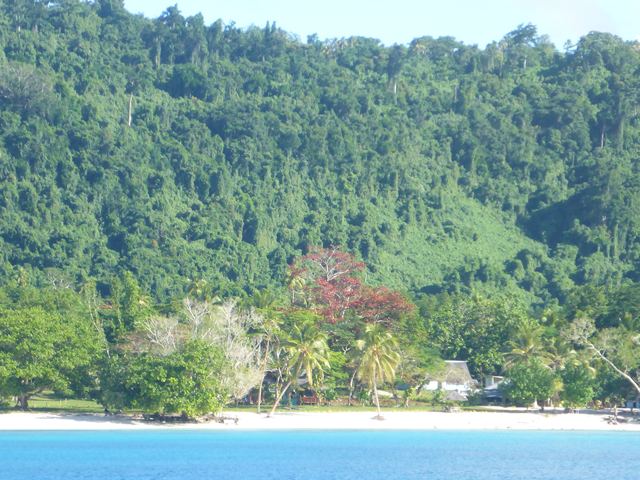
So whereas we might have wandered along the beach for a beer at the rustic bar, because they wanted to charge for the privilege they got no revenue from us at all. As we motored out of the bay the next morning we saw countless lovely beaches, longer and more attractive than that one.
A turtle came along to see us off and a black butterfly flew alongside Zoonie on our way to Port Olry where we have been anchored for the last five days. All the pictures after the first two were taken here. The dugong pictures are the best I could get as they barely break the surface. This one stayed around us all day and every five minutes or so would just break the surface to exhale, swim along a little, take a couple of breaths and then roll forwards for a dive with its tail just curving upward before it disappeared.

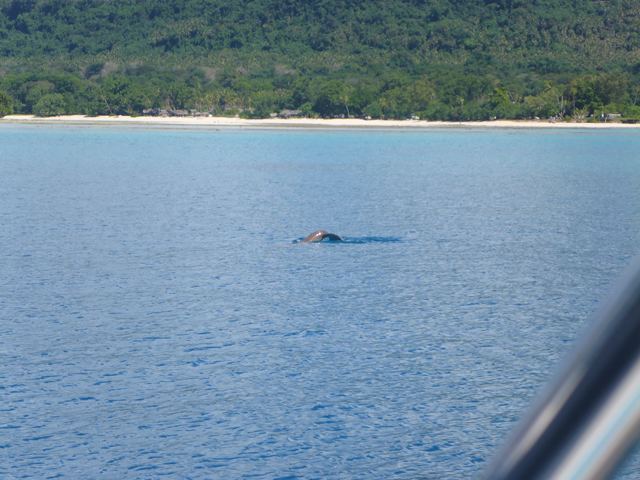
Rob and I went for a snorkel and hovered above a giant coral head as another turtle emerged and languorously moved away giving a lovely spell of viewing. There were scrapes along the coral from where the parrot fish nibble specs of food and familiar barred wrasse and trigger fish, banner fish, fusiliers and a big puffer fish which constantly changed colour and these were added to our mental collection. There is a lot of cyclone damage on the reefs but recovery starts straight after the storm has passed and we feel we must be optimistic. Poor ni Vanuatan people as they call themselves, if it’s not earthquakes and cyclones it’s volcanic eruptions. Their cheery nature is an embedded part of their survival instinct.
The next day the weather turned foul with what appears to be a squash zone between two High pressure areas reaching as far south as New Zealand and giving our friends there a wet and windy week too. The SE Trades run hard through these islands and when Bron from Nichola and Phil from the Dutch design German yacht, Parotia we had met in Luganville came aboard they reported 40 knots winds and standing waves just outside our anchorage. We have reef and islets around us but it is really the thumping lump of limestone next to us called Thion Island that makes this anchorage so sheltered and calm.
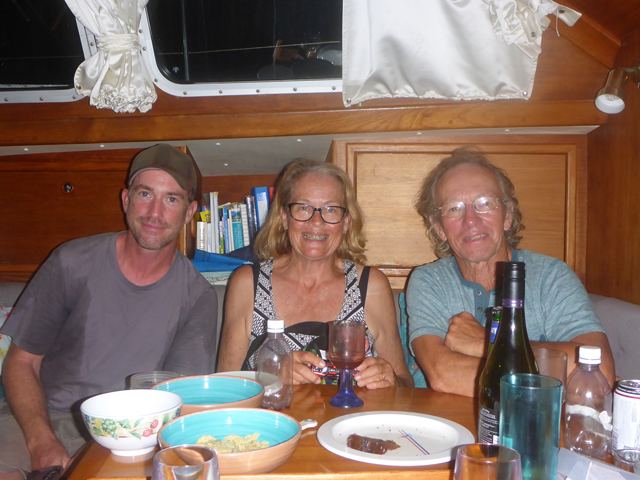

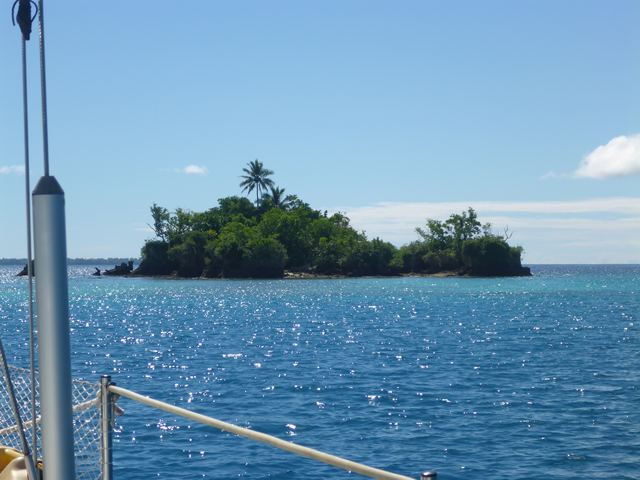

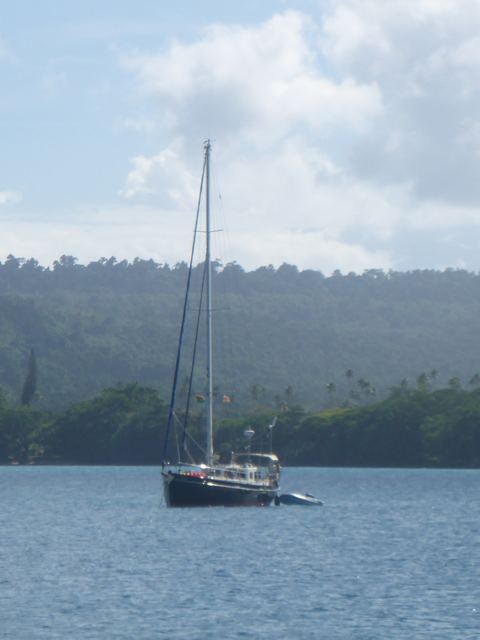
As the rain poured down fishermen in their dugouts with outriggers returned after their day of subsistence fishing, at least the rain is warm.
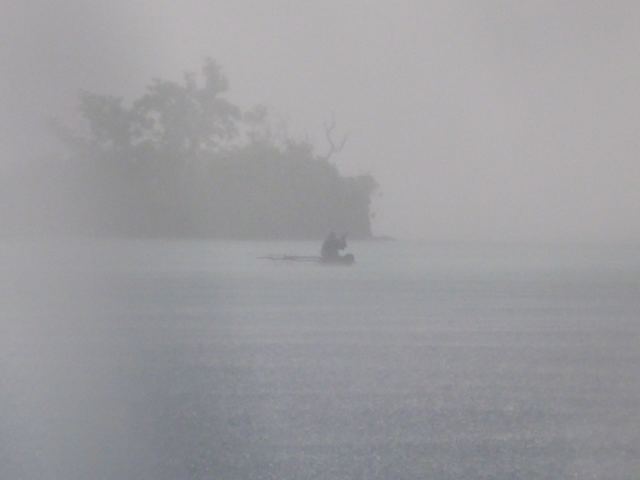
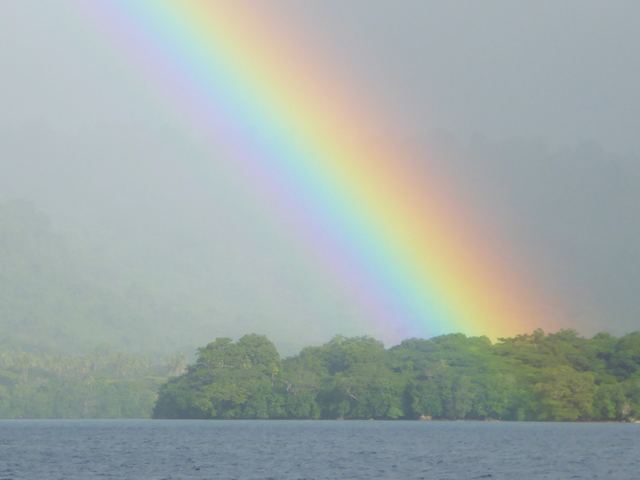
Yesterday morning just after 1.00am I was having a little potter around when I saw the 53 foot catamaran, Thor, that had come over the reef into our little lagoon and is now moored just inshore of us.
So when officially up and about we carried out our plan to visit the village of Port Olry about a mile from us and then visit Thor when we returned.
Motoring ashore carefully avoiding the remains of a wreck on the reef we discussed the Big Bay plan once more. We feared we might get weather bound yet again as we are now, if we went to Big Bay, taking away more days of potential exploring new places in the month we have allowed ourselves before we go south to Port Vila, the capital and where we will shed our three boxes of school uniforms.
The trades are running strong from the south east and by heading virtually east to the north end of Maewo Island we can then travel south down its sheltered west coast to a second anchorage at the bottom giving us a better angle to cross the trade winds towards Efate Island and the capital. It is around 55 miles to Maewo so it will be an early start on the next weather window which looks like Thursday, the day after tomorrow. But we all know how flexible our plans must be.
We climbed ashore for the first bit of walking exercise since leaving Luganville six days before and we found John in the shop who sold us a loaf of bread that looked very much liked the ones I bake on board. Upon my asking he said the population of the not so little village is around 4000 and growing. It is the second biggest village in Vanuatu.


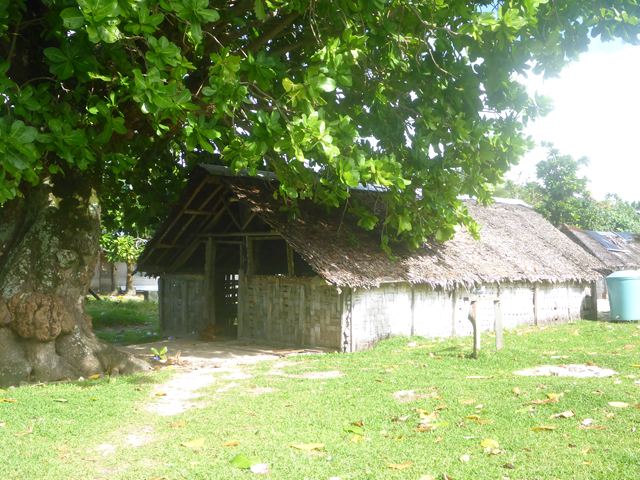
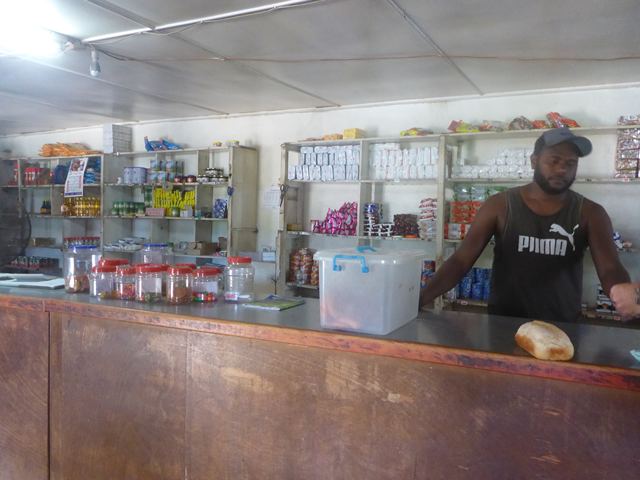
There is a big school and a college where children are educated right up to university age. Eleven fishing boats go further than the little dugouts and cast lines astern dropping 250 meters to catch a big red fish, Poulet (chicken fish) down in the depths and export it to Port Vila for good prices. Friendly villagers called greetings from the dark shade of their homes and Bianca, you can see in the photo, kindly offered us papayas and limes as a gift cut straight from the trees in her garden with her mum looking on from the doorway tending the two young grandchildren. The next photo is of the Bouquet Restaurant which looked very shut and after that the little shack with seats down each side is one of the numerous ‘kava bars’, the equivalent of our locals!

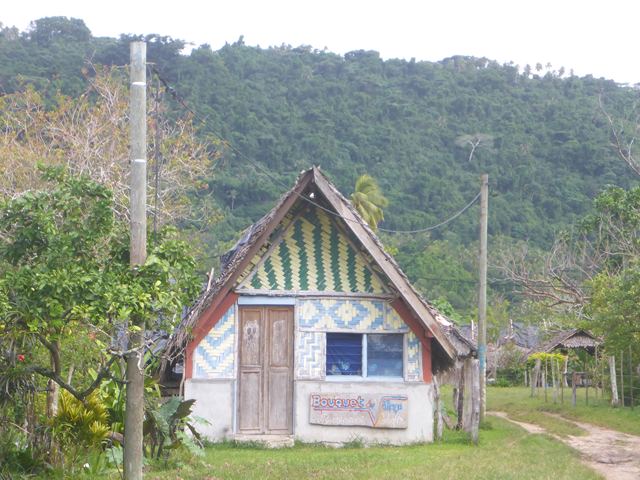

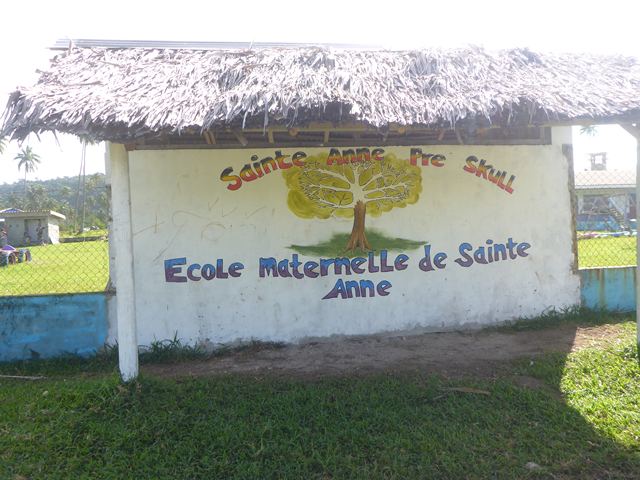


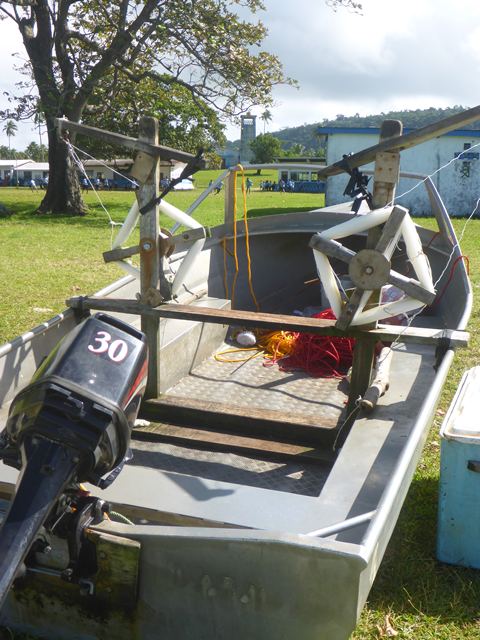
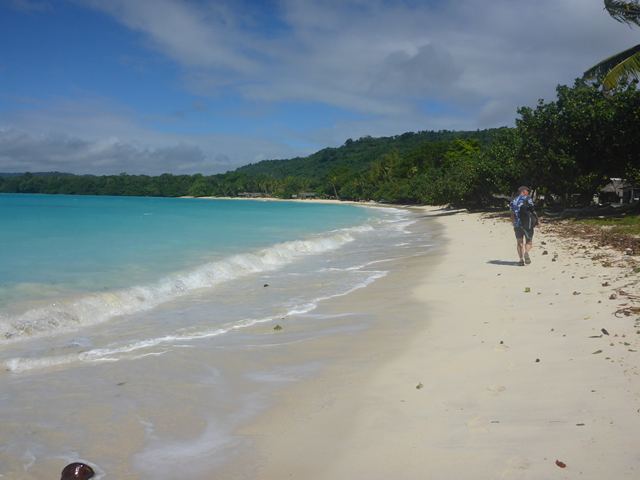
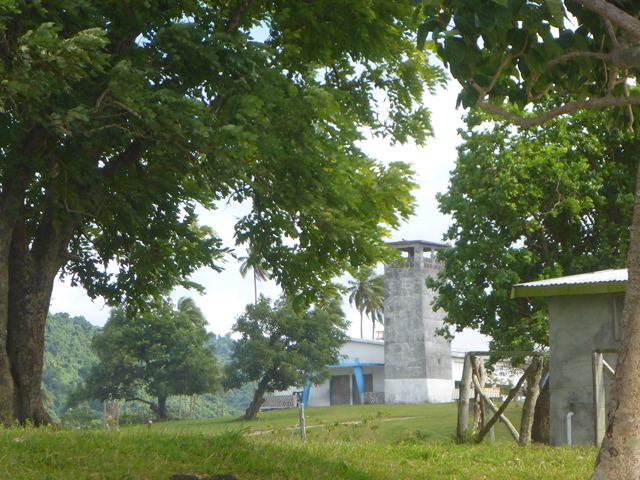
We motored over to see Mike and Ase aboard their cat for a coffee and later went to the beach at nearby Thion Island to hunt for the freshwater lake so Bron and Ken could get some fresh water. A flock of crested terns frequents the tip of the island as you can see.

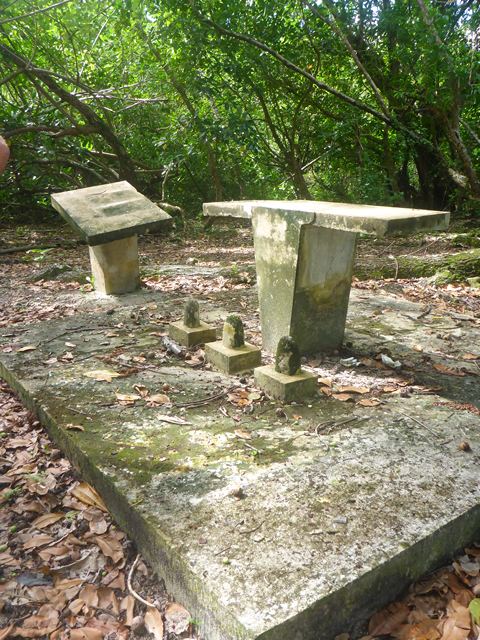

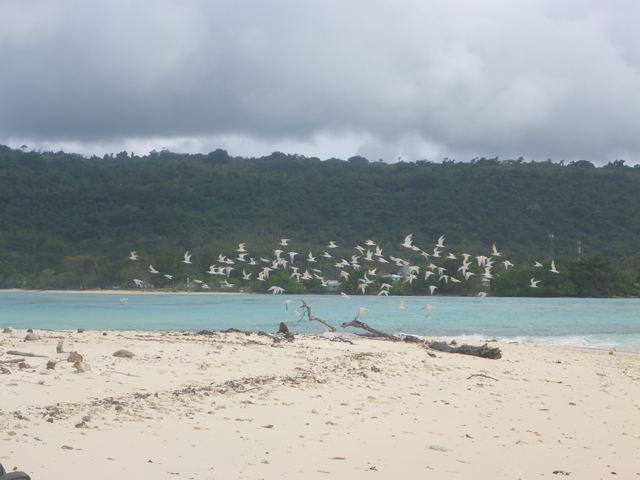
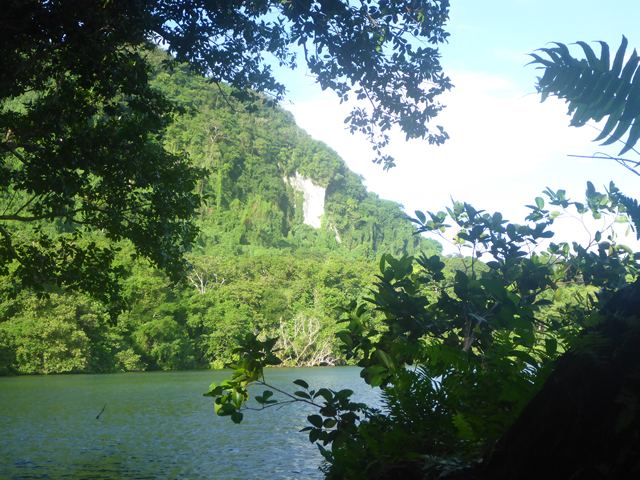
There are still cattle there, we noticed from the very fresh dung and new barbed wire fencing. We imagine the stone ‘table’ and three little upturned rocks on the concrete plinth and surrounded by a low wall of limestone rocks are graves, maybe from a time when the island supported a small settlement. Cattle ranching is big business on this island for the Vanuatan economy and is largely exported to Japan who like its high quality. Clearings provided grass for the cattle and the lake a source of water and we saw that the locals go ashore to collect coconuts.
I have mentioned recently the book ‘To the South Seas’ written around 1930 by Gifford Pinchot who took his family on a seven month cruise of the south west Pacific between two terms as Governor of Pennsylvania. Well he has a novel description of how some Pacific Islanders collect coconut crabs which I must tell you before I forget.
When the crab climbs the tree at night to cut off the coconuts and retrieve them back on the ground the natives put lots of rocks around the tree and wrap coconut matting around the trunk fairly well up the tree. Said crab, satisfied it has felled enough nuts starts to descend the tree. When its sensitive underparts feel the matting it thinks it has reached the ground and lets go of the trunk falling fatally onto the stones and is there ready for collection in the morning. There are still a few of the long lived beauties around but they are on the decline and unless the locals start to think conservation there soon will be none left.
The lake was easy to find, lying beneath a vertical wall of limestone and I wondered if there were any caves that might support a fruit bat population but we haven’t seen any as yet. Bron and Ken collect fresh water there regularly now and take a nice dip at the same time.
We all went on to Thor yesterday afternoon for what turned out to be Ase’s (pro Orsa) Birthday Tea Party and it was fascinating to hear about her career as a radar engineer with advanced skills in teaching her knowledge to others to inspire them to take the research even further without the constraints of traditional systems and methods. A real ground breaker.
The wind is still howling, so as to our departure…best hold this space!
